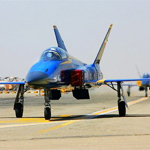Iran built jet fighter Saeqeh enters service

Iran takes a unique step forward in the world of military aviation with the announcement of the country’s first jet fighter squadron comprised of all Iranian aircraft. The HESA Saeqeh jet fighter; Iranian built and designed- now has become part of Iran’s Air Force. Saeqeh means ‘Thunderbolt’ in Iran and that name was applied to what was undoubtedly one of the best American WWII fighters, the P-47 Thunderbolt which had a ridiculous amount of horsepower toward the end of the war.
The name Thunderbolt is legendary in military aviation.
“The production of this kind of aircraft has been developing at high speed … and a fighter squadron of these fighter jets has been launched at one of the bases and is now flying,” The Iranian News Agency quoted Islamic Republic of Iran Air Force (IRIAF) Deputy Commander for Operations General Mohammad Alavi as saying on Saturday.
He says Iran will mass-produce the fighter jets, and that IRIAF, outfitted with revamped equipment, “was well prepared to defend the skies of the country.”
General Alavi also talked about Iran’s development of strategic weapons, which are ‘smart’ and capable of pinpointing objects. This technology would allow the Iranian jets the same general capabilities of western jet fighters.
Israel is still relying largely on the aging American F-16 single engine jet fighter that was the first ‘fly by wire’ jet fighter employing full computerization to activate flight surfaces and actually control the plane in flight. It certainly isn’t Israel’s only jet, but the F-16′ are Israel’s primary weapon when carrying out frequent deadly raids on civilian targets in Gaza.
Perhaps it is Israel and the U.S. specifically that have driven Iran to design and produce this seemingly cutting-edge aircraft. Wikipedia explains that is the Saeqeh is actually the second generation of the Iranian Azarakhsh fighter:
While there is little information on the specifications of the Saeqeh, my sense of ‘aircraft awareness’ was rewarded when I read that the two aircraft I immediately identified in looking at the Saeqeh, could not have been more on target. I was a U.S. Marine when the FA/18 Hornet first arrived at Marine Corps Air Station El Toro and all of us who were there will never forget how completely advanced this plane was next to our F-4 Phantoms and A-4 Skyhawks, which the Hornet replaced.
The similarity to the F/A-18 is easy to see; the trim design and twin boom tail and twin engine jet outlet located in the center of the aircraft are all very close. But this Iranian plane has an even sleeker and more sexy look on one hand, and that is where I spotted what I have to call my ‘favorite’ western jet fighter and that is the F-5 Tiger of Vietnam War fame that was originally designed to simulate eastern bloc MiGs.
This is the plane that the movie “Top Gun” used and called ‘MiG-28’s’ (which do not and never did exist; they were saying without saying, ‘MiG’29’ as that was the elusive Soviet plane that was of much concern to western air forces in the mid-80’s.) that were painted black with the essential red stars painted on the tails and wings.
According to Wikipedia, “Iranian officials have claimed that the Saeqeh is similar to the US-built F/A-18, although it is modeled after the US F-5E/F Tiger II and its outer appearance is similar to the latter.”
The Managing Director of the Aviation Organization of the Ministry of Defense and Logistics of the Armed Forces, Majid Hedayat, described the Saeqeh as a logistic and combat plane with high maneuvering capability and an ability to bombard close targets. The Marine Corps F/A-18 is designated as a fighter and attack aircraft which is what the Iranians mean when they discuss their plane’s ability to carry heavy bombs and also fly as a maneuverable, what we might call ‘dog fighter’ in the west.
As far as the data on the Saeqeh goes, there is no independent corroboration of Iran’s technical data on the plane and therefore no way to verify “official” claims. Iran announced in 2008 that the aircraft has a range of 3,000 kilometers, and the ability to track down enemy aircraft, engage them in combat, target ground attack locations, while carrying an assortment of weapons and ammunition.
And in case you are wondering, the distance between Tehran and Tel Aviv is 1,590 km., so in theory these planes could easily reach and attack Israel, but they would lack the fuel to return to Tehran.
According to General Alavi, in addition to the production of guided missiles similar to cruise missiles, Iran has also managed to revamp ground-based missiles that can be mounted on bombers.
He added that the Islamic Republic has also produced heavy high tonnage bombs with high destructive capabilities. “These bombs are also capable of pinpointing objects”, according to the Iranian commander.
He added that the Iranian Army has successfully ended the first stage of the mass-production of the bombs and it was now working to upgrade their efficiency.
I am anxious to see what other military aviation students, enthusiasts and participants have to say about this new advent in military aviation.
Tim King http://www.salem-news.com